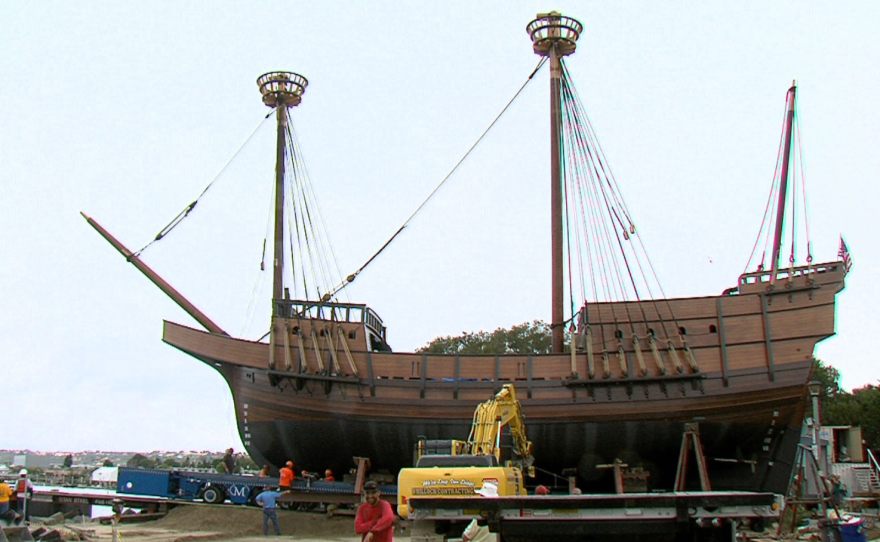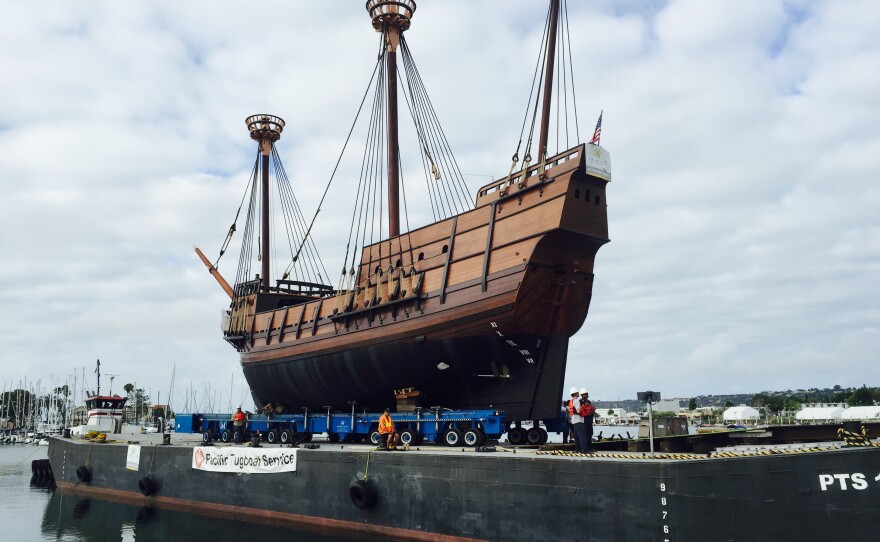
Over the past four years, a Spanish galleon ship has been taking shape in a park near downtown San Diego, becoming a spectacle for passers-by along Harbor Drive. By Wednesday morning, it was gone.
The San Salvador is officially no longer landlocked, although the formal debut of the ship won't happen until September.
The nearly 200-ton vessel was rotated to face the sea on Sunday. The next day, a heavy-load trailer was slid underneath the ship. On Tuesday, the trailer inched its way across a narrow bridge and onto a barge, which then slowly floated south. It will dock at a Chula Vista shipyard owned by Marine Group Boat Works, which donated the equipment and staff to move the wooden ship.
San Salvador project manager Mark Montijo said he has mixed feelings about seeing the ship go.
“It’s a bittersweet thing,” Montijo said. "We’re so excited to have this happen, but it’s kind of sad that this is coming to a close."
In 2011, San Diego Maritime Museum employees and some 400 volunteers began reconstructing a replica of the first ship to sail into San Diego Bay in 1542. Two-thirds of the crew were volunteers, which helped keep the project on budget at $6.2 million despite delays.
"Router Roy" Libby has put in 1,800 hours and was nervous to watch the people and equipment move it temporarily to Chula Vista.
"It's sort of like having a brand new baby that was just born, and then giving it to the nurse and she takes it away to another room," Libby said. "You go, 'I don't want that baby out of my sight.'"
Once it arrives safely in the South Bay, the San Salvador will hit water for the first time after a few more days of final touches.
During its construction, more than 1.2 million people visited the San Salvador as it took form in Spanish Landing Park. But Maritime Museum president Ray Ashley said the public site presented challenges.
"We built the ship in a parking lot, not a boatyard, so getting the ship into the water is not an easily done thing. And it's got to be done in stages," Ashley said. "This may be one of the slowest ship launches in history."
Ashley said he hopes the ship will make its official debut on the first day of the Festival of Sail on Sept. 4. If it's not ready by then, Ashley said Plan B is for it to launch on Sept. 28 — the same day that explorer Juan Rodríguez Cabrillo sailed his 200-ton Spanish Galleon into San Diego Bay in 1542, claiming the land for Spain and becoming the first European to set foot on the West Coast.


The ship is 92 feet long and 30 feet wide, rising up 60 feet tall with the masts installed. Made almost entirely of wood like the original San Salvador, it will weigh around 230 tons when complete.
"When she has her sails on and all her rigging complete, it'll be, you can't imagine, even more spectacular than now," volunteer Libby said.
Once it's launched and docked alongside the Maritime Museum's other ships on San Diego Bay, the San Salvador will take kids on educational sailing voyages up the California coast. Pending Coast Guard approval, the museum hopes to be able to sail with 49 passengers.
"This is the perfect complement to the Cabrillo National Monument," Libby said. "It's the best history teaching device we could have. The kids are going to love going on the boat, and they're going to remember the experience."







